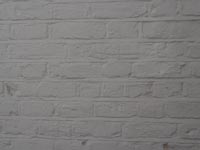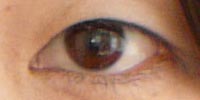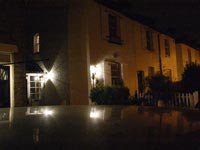Panasonic Lumix DMC-L1 Review
Review Date: March 20th 2007
Author: Gavin Stoker
Leave a comment about this Review
|
Image Quality
All of the sample images in this Review were captured using the 7.5M Fine (3072 x 2352) JPEG image size option producing a file that is around 3Mb in size.
Noise
The Panasonic Lumix DMC-L1 has 5 ISO settings. Noise is noticeable from ISO 400 upwards � nothing we haven�t witnessed before of course, and the L1 is not the worst offender, but it doesn�t quite for me deliver a result that justifies the outlay. Here are some 100% crops which show the noise levels for each ISO setting.
ISO 100 (100% Crop) |
ISO 200 (100% Crop) |
 |
 |
ISO 400 (100% Crop) |
ISO 800 (100% Crop) |
 |
 |
ISO 1600 (100% Crop) |
|
 |
Sharpening
Here are two 100% crops which have been Saved as Web - Quality 50 in Photoshop. The right-hand image has had some sharpening applied in Photoshop. The out-of-the camera images at the default setting are soft and benefit from some further sharpening in a program like Adobe Photoshop, or you change the in-camera sharpening level if you don't like the default results.
Original
(100% Crop)
|
Sharpened (100% Crop) |
 |
 |
 |
 |
Chromatic Aberrations
The Panasonic Lumix DMC-L1 dealt extremely well with chromatic aberrations during the review, with very limited purple fringing present around the edges of objects in high-contrast situations. Here is a 100% crop which shows the typical chromatic aberrations that you can expect:
|
Chromatic
Aberrations (100% Crop)
|
 |
Macro
The Panasonic Lumix DMC-L1 allows you to focus on a subject that is 29cms away from the camera with the supplied lens. The first image shows how close you can get to the subject (in this case a compact flash card). The second image is a 100% crop.
|
Macro Shot |
Macro Shot (100% Crop) |
 |
 |
Flash
The flash settings on the Panasonic Lumix DMC-L1 are Auto, Auto/Red-eye Reduction, Forced On/Red-eye Reduction, Slow Sync., Slow Sync./Red-eye Reduction, Forced On/Off. These shots of a white coloured wall were taken at a distance of 1.5m.
|
Flash Off - Wide Angle (28mm) |
Auto Flash - Wide Angle (28mm) |
 |
 |
|
Flash Off - Telephoto (100mm) |
Auto Flash - Telephoto (100mm) |
 |
 |
And here are some portrait shots. As you can see, neither the Forced On and Red-Eye Reduction options caused any amount of red-eye.
|
Flash On |
Flash On (100% Crop) |
 |
 |
|
Flash - Red-Eye Reduction |
Flash - Red-Eye Reduction (100% Crop) |
 |
 |
Night Shot
The Panasonic Lumix DMC-L1 maximum shutter speed is 60 seconds and there's also a Bulb mode, which is excellent news if you're interested in night photography. The shot below was taken using a shutter speed of 0.5 seconds, aperture of f/9 at ISO 1600. I've included a 100% crop of the image to show what the quality is like.
|
Night Shot |
Night Shot (100% Crop) |
 |
 |
Overall Image Quality
Given the combination of that price tag, the Leica lens whacked on the front � and the fact that I�d just tested Olympus� own Four Thirds baby the E-400 prior to the L1 and found images noticeably sharp and bright � I was expecting great things here. That�s not quite what I got � and here�s why. Though there�s little evidence of purple fringing unless you really, really look for it, even on an overcast day it�s easy to lose highlight detail unless you underexpose by a couple of stops, a slightly underexposed image being preferable to one devoid of detail. Though the above concerns are being picky, the biggest bugbear I found with the L1 was its inability � if left on auto � to determine accurate focus in low or filtered natural light. For me its performance in this respect was far less reliable than the likes of Nikon�s D40, which costs a third of the L1. The frustrating result being far more blurred or missed images than I�d have liked. Switching to manual focus, I found the visibility of the viewfinder could have done with being a lot brighter. Noise is also noticeable from ISO 400 upwards � nothing we haven�t witnessed before of course, and the L1 is not the worst offender, but it doesn�t quite for me deliver a result that justifies the outlay. There�s also, perhaps inevitably, some converging of verticals when shooting at extreme wide angle though the shots are not without dynamism. Could do better is the overall feeling; the L1 is not bad, but it requires a bit of work and a lot of patience to achieve the results you�re after.
|
![]() PhotographyBLOG
is a member of the DIWA
organisation. Our test results for the Panasonic Lumix DMC-L1 have
been submitted to DIWA
for comparison with test results for different samples of
the same camera model supplied by other DIWA
member sites.
PhotographyBLOG
is a member of the DIWA
organisation. Our test results for the Panasonic Lumix DMC-L1 have
been submitted to DIWA
for comparison with test results for different samples of
the same camera model supplied by other DIWA
member sites.
